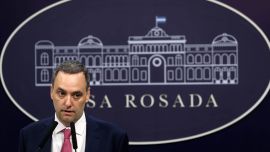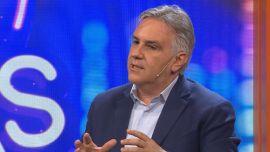Sunday’s election meant more than a change in the presidency. Offices for governor and mayor as well as seats in Congress, both the Chamber of Deputies, Argentina’s lower house of Congress, and its Senate, the upper house, faced potential turnover.
Beyond its demonstrative presidential victory, Frente de Todos, the party of the newly elected Alberto Fernandez and Cristina Fernandez de Kirchner, maintained its hold on one governorship—previously held by a Peronist who decided not to run— with one more still too close to call and won 13 new Senate seats, picking up majorities in five of the eight provinces that held such elections.
Meanwhile, Juntos por el Cambio, President Mauricio Macri’s party, looked on track to gain eight seats, giving them the majority in two provinces as well as in the City of Buenos Aires, which, like all provinces, has three representatives.
Buenos Aires City and Buenos Aires Province
Incumbent governor of Buenos Aires Province, María Eugenia Vidal, lost decidedly, taking only 38.6 percent of the vote as compared to the 52 percent of her opponent, Frente de Todos candidate Axel Kicillof.
Power won’t change in the capital city of Buenos Aires, however. Mayor Horacio Rodríguez Larreta was re-elected to a second term with 55 percent of the vote, the first candidate to win in a first round since the run-off process was introduced in 1994.
La Rioja
The race of the northeastern province pitted Peronist Ricardo Quintela against Senator Julio Martínez, President Mauricio Macri’s defence minister until the midterm elections in 2017.
As of late Sunday night, it was too close to call.
Catamarca
Raúl Jalil soundly defeated his Juntos por el Cambio opponent, Roberto Gomez. The margin of victory — nearly 27 percentage points — improved on Jalil’s performance in August’s PASO primaries. Jalil had the support of the incumbent, a fellow Peronist who had decided not to run for a third term. “I know the way he thinks and the way he works, and I believe he’s going to be a great governor,” she said.
After Jalil voted Sunday morning, he took to Twitter. “I want to thank all the neighbours and all those who have accompanied me on this journey[...] Every election is a chance to organize our democracy. With her we grow, and for her we should and do work,” he said.
Córdoba
At the presidential level, Córdoba remained loyal to President Mauricio Macri, a longtime advocate of Argentina’s agricultural sector, much of which is concentrated here.
Over 61 percent of the province voted for Macri, and it maintained its stronghold in the Chamber of Deputies with six seats to Frente de Todos' two (the last one belongs to a third party).
Entre Rios
The Juntos por el Cambio victory in Entre Rios surprised. With barely over 2,000 votes determining the winner, the party, which suffered a loss in the PASO race, came back to claim the majority in the Senate.
San Juan
The party of Alberto Fernandez enjoyed a decisive victory in the western province. More than 50 percent voted for him in the presidential race and over 55 percent voted to send Frente de Todos candidates to the Chamber of Deputies.
Chubut
One of the country’s poorest provinces, struggling with lack of resources and unemployment, voted to give Frente de Todos a shot in the next four years. The party won two seats in the Chamber of Deputies with nearly 52 percent.
Chaco
The border province of Chaco demonstrated its comment to Peronism by ushering in two senators and two deputies with a margin of victory of almost 20 percent.
– TIMES
























Comments